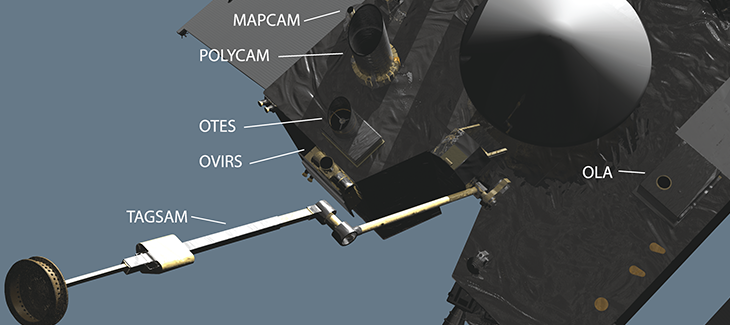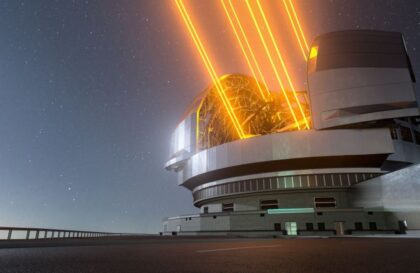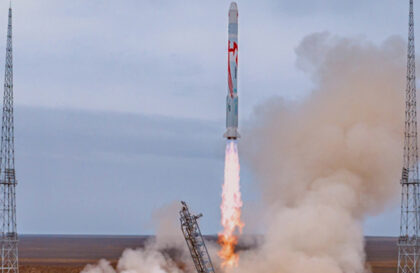OSIRIS-REx devices
There are five instruments on board the spacecraft that studied the asteroid in detail:
OVIRS is a spectrometer for measuring visible and near-infrared light. He determined the presence of organic substances and minerals.
OTES is a thermal emission spectrometer that uses infrared light to determine Bennu’s temperature and map its minerals and chemicals. Together with OVIRS, he created a map of Bennu to select sampling sites.
OCAMS is a set of three cameras. PolyCam captured the first photographs of Bennu and high-resolution images of the sampling site. MapCam detected satellites and dust plumes and created topographic maps. SamCam filmed the sample collection process.
PolyCam (center), MapCam (left), and SamCam (right) make up the OSIRIS-REx Camera Suite, responsible for most of the visible light images that will be taken by the spacecraft. Credit: University of Arizona/Symeon Platts
Mission timeline
After launch, the spacecraft performed two main maneuvers in space. The first occurred on December 28, 2016, sending the ship toward Earth to use gravity.
On September 22, 2017, OSIRIS-REx circled the Earth, accelerating toward Bennu. This maneuver increased his speed to 13,000 km/h. During its journey, OSIRIS-REx captured stunning images of the Earth and Moon from approximately 3 million miles (5 million km).
On June 28, 2018, the vehicle performed its final major maneuver in outer space, after which it began a series of maneuvers to approach Bennu, reaching it on December 3, 2018.
After examining the asteroid, scientists chose a place to collect samples – an area called Nightingale. On October 21, 2020, a short landing was successfully performed, activating a sampling device called TAGSAM. The landing lasted only six seconds.
The Touch-and-Go Sample Arm Mechanism is tested in the Lockheed Martin facility. The TAGSAM arm will be responsible for collecting a sample from Bennu’s surface. Credit: Lockheed Martin Corporation
When OSIRIS-REx approached the asteroid, TAGSAM sent a shot of pure nitrogen gas onto its surface. As a result of this action, regolith, consisting of dust and small stones, rose and was captured in the sample collection tube. Considering possible errors, OSIRIS-REx’s goal was to collect at least 60 g of asteroid material, ideally 150 g. NASA confirmed that the ship contained more than the minimum required volume of 60 g.
Despite achieving its target on the first attempt, OSIRIS-REx had two reserve nitrogen tanks for additional collection attempts. The maximum capacity of TAGSAM was 2 kg. To estimate the mass of the collected sample under weak gravity conditions, measurements of the angular acceleration of the apparatus were made before and after the procedure.
OSIRIS-REx ended its observation of Bennu on April 7, 2021, and returned to Earth on May 10. It will reach Earth on September 24, 2023, after which it will travel to the asteroid Apophis, where it plans to arrive in 2029.
Visit to Apophis
Apophis is a potentially dangerous asteroid, but NASA removed it from its threat list for the next 100 years thanks to improved data on its trajectory. On April 13, 2029, the 1,120-foot (340-meter) asteroid will pass within 19,000 miles (31,000 km) of Earth, closer than most satellites. However, it was previously thought that there was a risk of a collision in 2068; new data from 2021 rules out this risk. This close flyby gives NASA a unique opportunity to study the asteroid.
Image: The Planetary Society
In 2022, NASA decided to repurpose the OSIRIS-REx mission to explore the asteroid Apophis and rename it OSIRIS-APEX after samples from Bennu are returned to Earth. The new mission name will take effect in 2023, and the ship will reach Apophis in 2029.
The move carries risks, as the spacecraft will already be 13 years old by the time of the flyby and requires an additional investment of $200 million, increasing the mission’s total cost to $1 billion. However, this is more profitable than creating and launching a new ship.
Most of the ship’s instruments usually function, allowing OSIRIS-APEX to complete its mission effectively. A detailed study of Apophis is planned over 18 months, including exploration beneath its surface through a special maneuver.
It is worth noting that despite their similar size, Apophis and Bennu belong to different types of asteroids. While Apophis is an S-type associated with chondritic meteorites, Bennu is a B-type that may have once brought water to Earth.
Sampling missions on other asteroids
Asteroids are remnants of planet formation and provide windows into the early solar system. Their study provides insight into the processes of planet formation.
The OSIRIS-REx mission is part of a series of asteroid studies. While this is the first mission to return samples to the United States, Japan has already conducted two such missions: Hayabusa in 2010 and Hayabusa2 in 2020, bringing samples back to Earth.
Japan’s Hayabusa 2 spacecraft arrived at the asteroid Ryugu in 2018 Credit: Akihiro Ikeshita/JAXA
NASA also conducted the Dawn mission, which explored the asteroid Vesta and the dwarf planet Ceres. What makes OSIRIS-REx different is that its mission is to bring back samples from Bennu for detailed study on Earth. The goal is to collect at least 60 grams of material.
Additional OSIRIS-REx Objectives
Although OSIRIS-REx is studying potentially dangerous asteroid movements, there is no cause for concern. Despite their “potential danger,” this description is more statistical than alarming.
The mission also aims to study the Yarkovsky effect, where solar heat causes a slight change in the asteroid’s motion. This effect can accumulate over time and influence an asteroid’s trajectory, but studying it is difficult due to the differences in asteroid shapes.
Banner image: NASA/University of Arizona
Image credit:
https://www.nasa.gov
https://www.nasa.gov
https://www.nasa.gov
https://www.planetary.org
https://global.jaxa.jp






